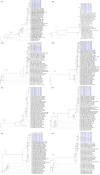Novel reassortant 2.3.4.4B H5N6 highly pathogenic avian influenza viruses circulating among wild, domestic birds in Xinjiang, Northwest China
- PMID: 34170087
- PMCID: PMC8318794
- DOI: 10.4142/jvs.2021.22.e43
Novel reassortant 2.3.4.4B H5N6 highly pathogenic avian influenza viruses circulating among wild, domestic birds in Xinjiang, Northwest China
Abstract
Background: The H5 avian influenza viruses (AIVs) of clade 2.3.4.4 circulate in wild and domestic birds worldwide. In 2017, nine strains of H5N6 AIVs were isolated from aquatic poultry in Xinjiang, Northwest China.
Objectives: This study aimed to analyze the origin, reassortment, and mutations of the AIV isolates.
Methods: AIVs were isolated from oropharyngeal and cloacal swabs of poultry. Identification was accomplished by inoculating isolates into embryonated chicken eggs and performing hemagglutination tests and reverse transcription polymerase chain reaction (RT-PCR). The viral genomes were amplified with RT-PCR and then sequenced. The sequence alignment, phylogenetic, and molecular characteristic analyses were performed by using bioinformatic software.
Results: Nine isolates originated from the same ancestor. The viral HA gene belonged to clade 2.3.4.4B, while the NA gene had a close phylogenetic relationship with the 2.3.4.4C H5N6 highly pathogenic avian influenza viruses (HPAIVs) isolated from shoveler ducks in Ningxia in 2015. The NP gene was grouped into an independent subcluster within the 2.3.4.4B H5N8 AIVs, and the remaining six genes all had close phylogenetic relationships with the 2.3.4.4B H5N8 HPAIVs isolated from the wild birds in China, Egypt, Uganda, Cameroon, and India in 2016-2017, Multiple basic amino acid residues associated with HPAIVs were located adjacent to the cleavage site of the HA protein. The nine isolates comprised reassortant 2.3.4.4B HPAIVs originating from 2.3.4.4B H5N8 and 2.3.4.4C H5N6 viruses in wild birds.
Conclusions: These results suggest that the Northern Tianshan Mountain wetlands in Xinjiang may have a key role in AIVs disseminating from Central China to the Eurasian continent and East African.
Keywords: H5N6; Highly pathogenic avian influenza virus; poultry; reassortant; wild bird.
© 2021 The Korean Society of Veterinary Science.
Conflict of interest statement
The authors declare no conflicts of interest.
Figures

Similar articles
-
Genetic diversity of highly pathogenic avian influenza H5N6 and H5N8 viruses in poultry markets in Guangdong, China, 2020-2022.J Virol. 2025 Jan 31;99(1):e0114524. doi: 10.1128/jvi.01145-24. Epub 2024 Dec 4. J Virol. 2025. PMID: 39629997 Free PMC article.
-
Rapid Emergence of the Reassortant 2.3.4.4b H5N2 Highly Pathogenic Avian Influenza Viruses in a Live Poultry Market in Xinjiang, Northwest China.Avian Dis. 2021 Dec;65(4):578-583. doi: 10.1637/aviandiseases-D-21-00075. Avian Dis. 2021. PMID: 35068101
-
Novel reassortment 2.3.4.4b H5N8 highly pathogenic avian influenza viruses circulating in Xinjiang, China.Prev Vet Med. 2022 Feb;199:105564. doi: 10.1016/j.prevetmed.2021.105564. Epub 2021 Dec 22. Prev Vet Med. 2022. PMID: 34959041
-
The genetics of highly pathogenic avian influenza viruses of subtype H5 in Germany, 2006-2020.Transbound Emerg Dis. 2021 May;68(3):1136-1150. doi: 10.1111/tbed.13843. Epub 2020 Sep 29. Transbound Emerg Dis. 2021. PMID: 32964686 Review.
-
Intracontinental and intercontinental dissemination of Asian H5 highly pathogenic avian influenza virus (clade 2.3.4.4) in the winter of 2014-2015.Rev Med Virol. 2015 Nov;25(6):388-405. doi: 10.1002/rmv.1857. Epub 2015 Oct 13. Rev Med Virol. 2015. PMID: 26458727 Review.
Cited by
-
Virulence and transmission characteristics of clade 2.3.4.4b H5N6 subtype avian influenza viruses possessing different internal gene constellations.Virulence. 2023 Dec;14(1):2250065. doi: 10.1080/21505594.2023.2250065. Virulence. 2023. PMID: 37635408 Free PMC article.
-
H5 subtype avian influenza virus induces Golgi apparatus stress response via TFE3 pathway to promote virus replication.PLoS Pathog. 2024 Dec 9;20(12):e1012748. doi: 10.1371/journal.ppat.1012748. eCollection 2024 Dec. PLoS Pathog. 2024. PMID: 39652582 Free PMC article.
References
-
- World Health Organization. Antigenic, Genetic Characteristics of Zoonotic Influenza A Viruses, Development of Candidate Vaccine Viruses for Pandemic Preparedness [Internet] [Updated 2021]. [Accessed 2021 Mar]. https://www.who.int/influenza/vaccines/virus/202103_zoonotic_vaccineviru....
-
- Bi Y, Chen Q, Wang Q, Chen J, Jin T, Wong G, et al. Genesis, evolution and prevalence of H5N6 avian influenza viruses in China. Cell Host Microbe. 2016;20(6):810–821. - PubMed
MeSH terms
Grants and funding
LinkOut - more resources
Full Text Sources
Medical
Miscellaneous

